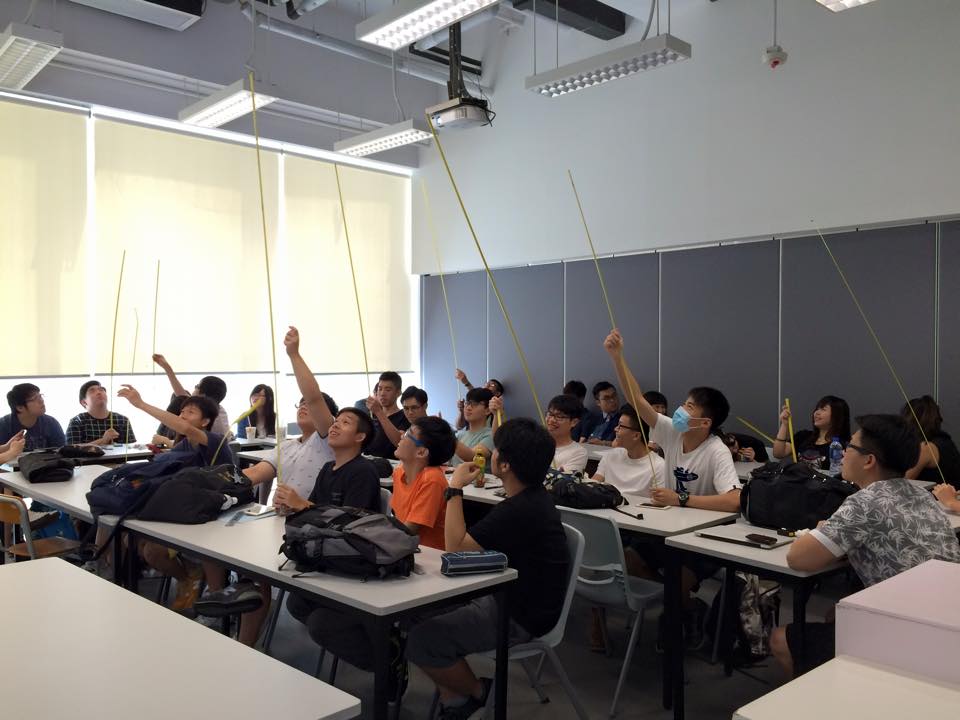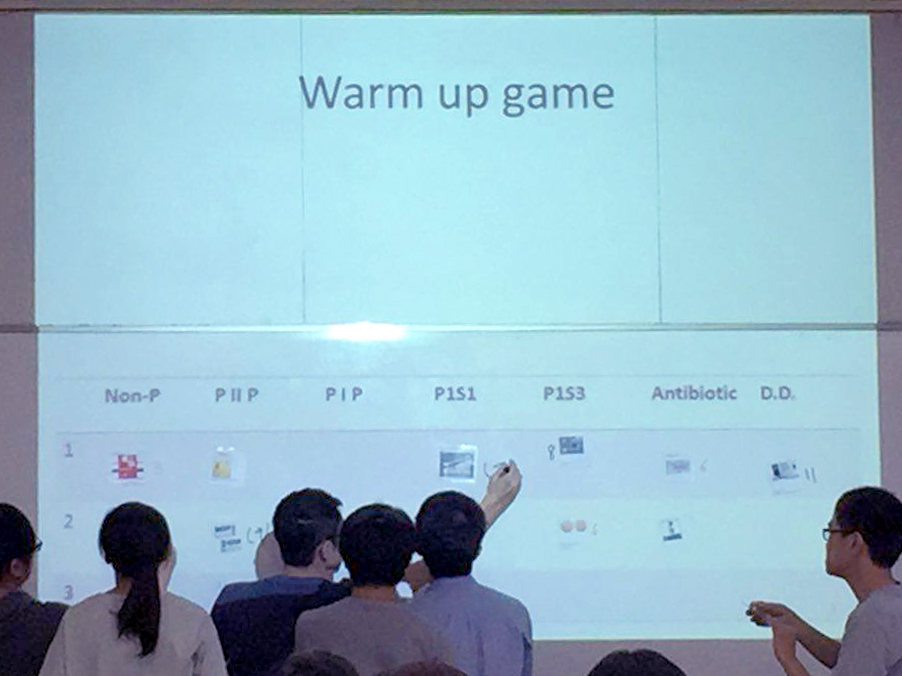大班教學的竅門
對於何謂「大班教學」,教師和行政人員都有不同的定義。由於沒有一個一致的定義,我們一般認為大班是指面對特定的學生數目下,教師需要更努力去管理學生,但有關的付出卻未必能有助學與教的成效(Bahanshal,2013)。很多因素會構成大班教學,包括資源有限和收生意外地增加。不管甚麼原因,大班教學已成為專上教育普遍的教學模式。
縱使已有很多關於學生數目增加而產生教學問題的研究指出學習的成效其實更取決於教學的設計,而不是班的人數(McKeachie,1990)。在同樣的環境下,通過採用適當的教學策略,大班教學的教學效能未必比小班教學弱。我們希望以下的點子能有助教師促進學生於大班教學裡的學習。
讓學生積極參與
一般的課堂為三小時或以上,但學生的專注力卻比較短。研究指出,要學生專心致志地聽課超過十五分鐘可能比較困難 (Briggs, 2014)。因此,教師可為大班作適當調適以促進學生主動學習,如腦震盪、課堂討論、角色扮演和學生匯報。除了通過向學生提問來了解學生的學習情況,教師亦可以鼓勵學生對課堂內容提出問題。此外,把講課劃分幾部份可以轉移學習焦點,重奪學生的注意力。
 學生於課堂積極參與:在室內設計課裡,學生嘗試利用拉尺去量度天花板的高度。
(相片由Timothy Cheng提供,2015)
學生於課堂積極參與:在室內設計課裡,學生嘗試利用拉尺去量度天花板的高度。
(相片由Timothy Cheng提供,2015)
運用「三的法則」
有說「三個一組」的概念或點子比較有趣,而且更吸引人和更令人難忘。當教師在大班教學裡要向學生傳遞大量資訊和概念時,可運用「三的法則」來整理訊息。例如,教師可使用以三樣為一個項目的法則來擬訂簡報結構和講義。教師在總結課堂時,也可以把關鍵訊息以三為「意元」(將資訊集合成一組的記憶單位)。
幫助學生建立團體感
學生對大班教學的其中一個不滿就是學生的「匿名」性,這可能導致學生缺乏主動學習的意願及降低學生的學習動機。因此,在開課早期幫助學生與其他同學建立關係是非常重要的。一個溫暖和友好的學習環境一旦形成,學生們會感到舒服,從而樂意參與課堂。
利用資訊科技和視覺工具
隨著科技的進步,課堂學習已經超越了傳統的黑板講授。利用多媒體和演講錄影系統不僅能激發學生的學習興趣,而且還能維持學生的投入參與及豐富學習經驗。在大班教學的環境中,科技為教師和學生造就了靈活的學和教經驗。透過資訊科技,課程教材、參考資料、教學示範短片和試題練習,均可以在網上或應用程式上提供,讓學生隨時隨地存取複習。
此外,Dale (1969) 的「經驗金字塔」提出,大多數人透過聽和看能更有效地保留信息。採用視覺工具不單指運用豐富多彩的投影片和字體,也包括圖表、故事分鏡、圖片和實物道具的使用。適當使用視覺工具能幫助學生理解資訊和知識,亦令課堂更有趣。
 關係藥物管制條例的配對遊戲激發學生學習興趣。
(相片由教學中心提供,2015)
關係藥物管制條例的配對遊戲激發學生學習興趣。
(相片由教學中心提供,2015)
大班教學通常意味著教授一班來自不同背景,擁有不同學習特質的學生。這對教師的教學有相當的挑戰性。因此,採用多元化的教學方法來建立以學生為中心的學習環境是很重要的。
Tips on Engaging Students in a Large Class
Both teachers and administrators have different interpretations as to what is meant by “large class”. As there is no consensus on the definition to what constitutes a large class, we generally believe that large classes are those with a specific number of students that teachers need greater efforts to handle, which the effectiveness of learning and teaching is being questioned (Bahanshal, 2013). Large class size may be the result of many factors, including limited resources and unexpected high enrolment. No matter what the cause is, teaching large classes has been a common teaching practice in tertiary institutions.
Although many studies specifically stress the issues and problems raised by the increase in number of students and class size, it is more about instructional design rather than class size which determines the effectiveness of learning and teaching (McKeachie, 1990). By employing proper teaching strategies, teaching a large class may not be any less effective than a small class in the same context. The following strategies may help you to keep your students engaged in a large class.
Get students actively involved
The duration of a class could be three hours or longer, but students’ attention spans may be fairly short. Some studies show that it may be difficult for students to concentrate for over 15 minutes in a lecture (Briggs, 2014). Hence, teachers could engage students in active learning activities in lectures, which may include brainstorming, class discussion, role-play and student presentation. Besides asking questions to students, teachers could ask students to provide questions related to class content. Meanwhile, dividing the lecture into segments could allow a shift of focus and recapture students’ attention.
 Actively participating in a lecture, the students try to find out the height of the ceiling with a measuring tape in an interior design class.
(Photo courtesy of Timothy Cheng, 2015)
Actively participating in a lecture, the students try to find out the height of the ceiling with a measuring tape in an interior design class.
(Photo courtesy of Timothy Cheng, 2015)
Use the Rule of Three
It has been said that concepts or ideas come in a number of three are more interesting, more appealing and more memorable. When delivering substantial amounts of information and concepts to students in a large class, teachers may structure the information and concepts into threes. For example, teachers could use lists of three when presenting ideas in PowerPoint slides and handouts. Moreover, teachers could wrap or summarise the class by presenting three key information of the class content.
Help students develop a sense of community
One of the dissatisfactions among students with large class learning is the feeling of anonymity in class. This may result in poor student engagement and low motivation. Hence, helping students establish relationships with other students in class early on is important. Once a warm and friendly learning environment is formed, students would feel comfortable to participate in class.
Make use of technology and incorporate visual aids
With the advancement of technology, classroom learning has gone beyond the classic chalk and talk. The use of multimedia and video capture system not only arouse students’ interests, but also sustain engagement and enrich learning experiences. In the setting of large class teaching, technology enables a flexible learning and teaching experience to both teachers and students, since course materials, reference materials, demonstration video clips and practice assessment could be made available online or on mobile apps for students to access anytime they prefer.
Moreover, Dale’s (1969) “Cone of Experience” suggested that most people retain information better when they both hear and see it. Employing visual aids does not necessary mean elaborating PowerPoint presentation on colourful slides and typeface only; it also refers to the use of diagrams, charts, storyboards, images and physical props. The incorporation of visual aids assists students in understanding the information and knowledge. It also makes the class more interesting.
 Students are interested in the matching games about pharmaceutical products and registration.
(Photo courtesy of CLT, 2015)
Students are interested in the matching games about pharmaceutical products and registration.
(Photo courtesy of CLT, 2015)
Teaching a large class usually means teaching a class of students with a wide spectrum of learning curves and backgrounds. It could be challenging to teachers. Therefore, it is recommended that teachers should apply multiple teaching methods to engage students and foster a student-centred learning environment.
 學生於課堂積極參與:在室內設計課裡,學生嘗試利用拉尺去量度天花板的高度。
(相片由Timothy Cheng提供,2015)
學生於課堂積極參與:在室內設計課裡,學生嘗試利用拉尺去量度天花板的高度。
(相片由Timothy Cheng提供,2015) 關係藥物管制條例的配對遊戲激發學生學習興趣。
(相片由教學中心提供,2015)
關係藥物管制條例的配對遊戲激發學生學習興趣。
(相片由教學中心提供,2015) Actively participating in a lecture, the students try to find out the height of the ceiling with a measuring tape in an interior design class.
(Photo courtesy of Timothy Cheng, 2015)
Actively participating in a lecture, the students try to find out the height of the ceiling with a measuring tape in an interior design class.
(Photo courtesy of Timothy Cheng, 2015) Students are interested in the matching games about pharmaceutical products and registration.
(Photo courtesy of CLT, 2015)
Students are interested in the matching games about pharmaceutical products and registration.
(Photo courtesy of CLT, 2015)